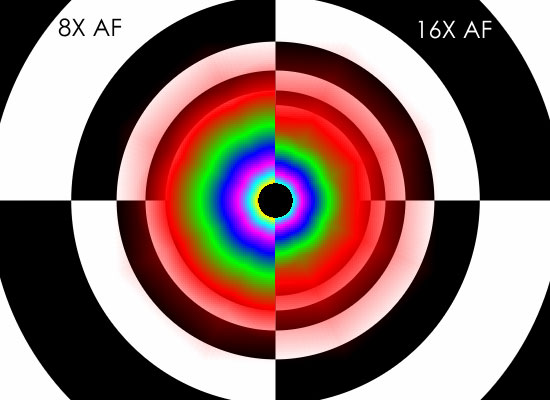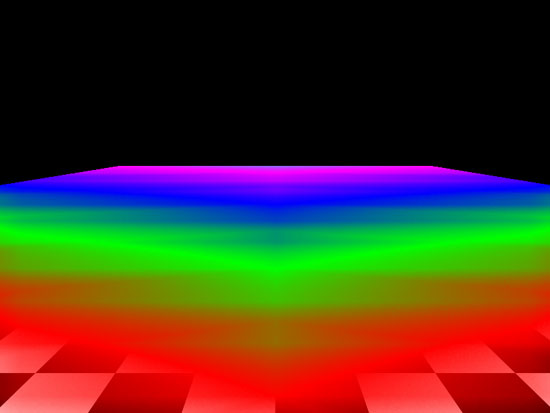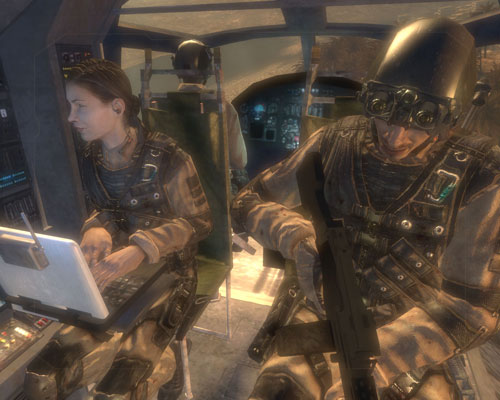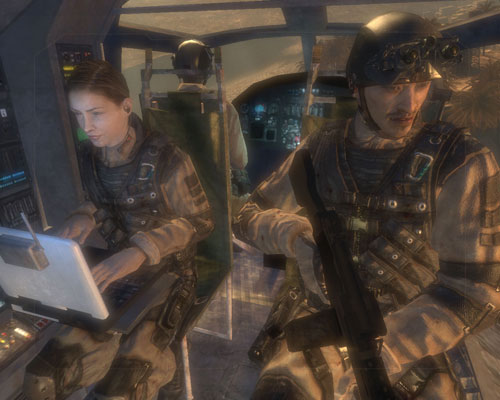ATI Radeon HD 2900 XT: Calling a Spade a Spade
by Derek Wilson on May 14, 2007 12:04 PM EST- Posted in
- GPUs
General Image Quality
Beyond antialiasing, there are quite a number of factors that go into making real-time 3D look good. Real-time graphics are an optimization problem, and the balance between performance and quality is very important. There is no single "right" way to do graphics, and AMD and NVIDIA must listen carefully to developers and consumers to deliver what they believe is the sweet spot between doing things fast and doing things accurately.
NVIDIA currently offers much more customizable image quality. Users are able to turn on and off different optimizations as they see fit. AMD really only offers a couple specific settings that affect image quality, while most of their optimizations are handled on a per game basis by the ominous feature known as Catalyst A.I. The options we have are disabled, standard and advanced. This doesn't really tell us what is going on behind the scenes, but we leave this setting on standard for all of our tests, as this is the default setting and most users will leave it alone.
Aside from optimizations, texture filtering plays a large role in image quality when high levels of filtering are called for. It's trivial to point sample or bilinear filter, and no one skimps on these duties, but when we get to trilinear and anisotropic filtering the number of texture samples we need and the number of calculations we must perform per pixel go up very quickly. In order to mitigate the cost of these operations, both AMD and NVIDIA attempt to apply high levels of filtering where they are needed and not-so-high levels of filtering where it won't matter that much. Of course there is much debate over where to draw the lines here, and NVIDIA and AMD both choose different paths.
To investigate texture filtering quality, we have employed the trusty D3D AF-Tester. This long-lived application enables us to look at one texture with different colored mipmap levels to see how hardware handles filtering them under different settings. Thankfully, we don't have to talk about angle dependent anisotropic filtering (which is actually a contradiction in terms anyway). AMD and NVIDIA both finally do good quality anisotropic filtering that results in higher resolutions textures being used more of the time where possible. Take a look at these images to see how the different hardware stacks up.

NVIDIA G80 Tunnel 8x/16x AF
G80
R5xx
R6xx
It still looks like NVIDIA is doing slightly more angle independence filtering. In practice, it will be very difficult to tell the difference between an image rendered on AMD hardware and one rendered on NVIDIA hardware. We can also see that AMD has slightly tweaked their AF technique to eliminate some of the odd transitions we noticed on R5xx hardware. This comes through a little better if we look at a flat plane:

AMD R600 Plane 8x AF
R5xx
R6xx
We did happen to notice at least one image quality issue not related to texture filtering on AMD hardware. The problem turns up in Rainbow Six: Vegas in the form of very bad banding where we should see HDR lighting. We didn't notice this problem on G80, as we can see from our comparison.
  |
| Click to enlarge |
We also noticed a small issue with Oblivion at one point where the oblivion gate shader would bleed through other objects, but this was not reproducible and we couldn't get a screenshot of it. This means it could be a game related issue rather than a hardware or driver problem. We'll keep our eyes peeled.
Overall IQ of the current DX10 hardware available is quite good, but we will continue to dig further into the matter to make sure that everything stays that way. We're also waiting for DX10 games before we can determine if there are other differences, but hopefully that won't be the case as DX10 has a single set of requirements.










86 Comments
View All Comments
GoatMonkey - Monday, May 14, 2007 - link
That's obviously BS. This IS their high end part, it just doesn't perform as well as nVidia's high end part, so it is priced accordingly.poohbear - Monday, May 14, 2007 - link
sweet review though! thanks for including all the important and pertinent cards in your roundup (the 8800gts 320mb inparticular). also love how neutral Anand is in their reviews, unlike some other sites.:pCreig - Monday, May 14, 2007 - link
The R600 is finally here. I'm sure the overall performance is not what AMD was hoping for. Nobody ever shoots to have their newest product be the 2nd best. But pricing it at $399 and including a very nice game bundle will make the HD 2900 XT a VERY worthwhile purchase. I also have the feeling that there is a significant amount of performance increase to be realized through future driver releases ala X1800XT.shady28 - Tuesday, May 15, 2007 - link
Nvidia has gone over the cliff on pricing.
I know of no one personally who has an 88xx series card. I know one who recently picked up an 8600 of some kind, that's it. I have the best GPU of anyone I know.
It's a real shame that there is so much focus on graphics cards that virtually no one buys. These are niche products folks - yet 'who is best' seems to be totally dependent on these niche products. That's patently ridiculous.
It's like saying, since IBM makes the fastest computers in the world (they do), they're the best and you should be buying IBM (or now, lenovo) laptops and desktops.
No one ever said that sort of thing because it's patently ridiculous. Why do people say it now for graphics cards? The fact that they do says a lot about the mentality of sites like AT.
DerekWilson - Tuesday, May 15, 2007 - link
We don't say what you are implying, and we are also very upset with some of NVIDIA's pricing (specifically the 8800 ultra)the 8800 gts 320mb is one of the best values for your money anywhere and isn't crazy expensive -- it's actually the card I'd recommend to anyone who cares about graphics in games and wants good quality and performance at 1600x1200.
I would never tell anyone to buy an 8600 gts because nvidia has the fastest high end card. In fact, in this article, I hope I made it clear that AMD has the opportunity to capitalize on the huge performance gap nvidia left between the 8600 and 8800 series ... If AMD builds a part that performs in this range is priced competitively, they'll have our recommendation in a flash.
Recommending parts based on value at each price or performance segment is something we take pride in and will always do, no matter who has the absolute fastest hardware out there.
The reason our focus was on AMD's fastest part is because they haven't given us any other hardware to test. We will absolutely be talking a lot and in much depth about midrange and budget hardware when AMD makes these parts available to us.
yacoub - Monday, May 14, 2007 - link
$400 is a lot of money. Not terribly long ago the highest end GPU available didn't cost more than $400. Now they hit $750 so you start to think $400 sounds cheap. It's really not. It's a heck of a lot of money for one piece of hardware. You can put together a 650i SLI rig with 2GB of DDR2 6400 and an E4400 for that much money. I know because I just did that. I kept my 7900GT from my old rig because I wanted to see how R600 did before purchasing an 8800GTS 640MB. Now that we've seen initial results I will wait to see how R600 does with more mature drivers and also wait to see the 640MB GTS price come down even more in the meantime.vijay333 - Monday, May 14, 2007 - link
http://www.randomhouse.com/wotd/index.pperl?date=1...">http://www.randomhouse.com/wotd/index.pperl?date=1..."the expression to call a spade a spade is thousands of years old and etymologically has nothing whatsoever to do with any racial sentiment."
yacoub - Monday, May 14, 2007 - link
Yes, a spade was a shovel long before muslims enslaved europeans to do hard labor in north africa and europeans enslaved africans to do hard labor in the 'new world'.vijay333 - Monday, May 14, 2007 - link
whoops...replied to the wrong one.rADo2 - Monday, May 14, 2007 - link
It is not 2nd best (after 8800ULTRA), not 3rd best (after 8800GTX), not 4th best (after 8800GTX-640), but 5th best (after 8800GTS-320), or even worse ;)Bad performance with AA turned on (everybody turns on AA), huge power consumption, late to the market.
A definitive failure.